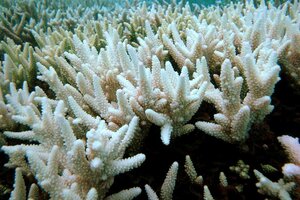Good news for reefs: how corals could survive a warming planet
New genetics research shows how cold-water corals can increase their resilience to global warming at a pace that could match climate change.

A bleached section of Australia's Great Barrier Reef, which scientists have warned could be killed by global warming within decades.
Great Barrier Reef Marine Park Authority
As concern grows over the threat coral reefs face from pollution, destructive fishing practices, and especially climate change and ocean acidification, a research team has found that heat-tolerant corals pass along that tolerance to corals adapted to cooler waters.
One of the key questions regarding heat tolerance is the extent to which it is genetically inherited or whether the corals build an ability to endure heat stress through repeated exposure, a process analogous to hardening tomato plants.
If the trait is inherited, it could provide a mechanism for what the team dubs "genetic rescue," in which natural crossbreeding between warmer- and cooler-water corals gives the cool-water variants the genetic tools they need to cope with rising ocean temperatures, at least for a while.
Modeling studies suggest that even a modest ability to adapt could have a significant impact on the longevity of reefs, notes Mikhail Matz, a marine geneticist at the University of Texas at Austin and one of two senior authors of a research paper reporting the crossbreeding results in Friday's issue of the journal Science.
For instance, genetically rooted heat tolerance in corals could delay high-frequency mass-bleaching events by up to 80 years, compared with no adaptive response, according to a study published last year in the journal Global Change Biology. Heat tolerance from temporary increases in resistance delayed the onset of high-frequency bleaching events for only about 10 years.
Bleaching events result from heat or cold stress and boost corals' vulnerability to other stresses. Prolonged bleaching is fatal to coral.
Even a modest capacity for adaptation, if heritable, "buys us a lot of time," Dr. Matz says.
Interest in finding ways to enhance the heat resistance of corals to build resilience into reefs is a relatively recent development, notes Hollie Putnam, a researcher at the University of Hawaii's Institute of Marine Biology who focuses on the factors that contribute to corals' ability to tolerate heat.
"The general thought is that the rate of climate change is progressing too rapidly for genetic adaptation to be of much help," she says. But for corals, little has been done to date to address the question.
The new study is taking an initial look at the issue in some detail – "the first step in assessing how far we can go and how quickly in terms of genetic adaptation," she says.
The team's work involved a species of branching coral found along Australia's Great Barrier Reef known as Acropora millepora.
The researchers gathered samples of the coral from locations separated by about 5 degrees of latitude – two corals from a warm-adapted population and two from a cold-adapted population. They took the coral into the lab just before they were about to spawn and set each in it own container. The corals are hermaphrodites, producing sperm and gametes from the same organism. So they removed the gametes and then mixed them among the four corals.
"Every coral became a mom or a dad to every other coral," he says. The researchers reared the resulting larvae in the lab, then tested them for heat tolerance.
The team found that the odds of survival under heat stress for larvae spawned only from warm-water parents were 10 times higher than for larvae only from cool-water parents.
But even mixed parentage helped. The odds of survival for larvae from a warm-water dam and cool-water sire were seven times higher than for larvae with two cool-water parents. Survival odds were twice as high for larvae from a warm-water sire and cool-water dam than for larvae only from cool-water parents.
The results not only pointed to heritability, but heritability's benefit to blends between the cool- and warm-adapted populations.
While the results are based only on a single species, "it is very, very likely that most coral species share the same life history," Matz says. So the results likely extend to many other corals – although, he adds, this still needs to be tested.
The results are encouraging, says Les Kaufman, a marine biologist at Boston University. The new work points out that natural cross-fertilization also can occur in a north-south direction – particularly important since warmer waters are working their way into higher latitudes with global warming.
For the north-south trending Great Barrier Reef, tickled by a coastal current that flows south along Australia's east coast, the results imply that to some extent, nature can be left to take its course in distributing increased heat tolerance to the reef's southern reaches. But elsewhere, humans might have to step in.
In February, Dr. Putnam and three colleagues from the US and Australia published an article in the Proceedings of the National Academy of Sciences laying out the case for helping corals through assisted evolution – essentially a selective-breeding program designed to boost heat tolerance.
In addition, researchers are exploring the effect different micro-algae could have in improving reef-building corals' heat tolerance, Dr. Putnam says.
Selective breeding would not be used to introduce novel, if heat-tolerant, corals to a reef-resilience project, she adds. Instead, it "would bring together the super performers that are really doing well" on the reef "and propagating that out into the future."
For Matz, however, the new results for A. millepora point to the potential that assisted colonization could have in building reef resilience to warming.
Boston University's Kaufman agrees, but cautions that the prospect could be daunting.
"Imagine trying to do this across all coral taxa. And what about all the non-coral species that play key roles" in coral-reef communities? he asks.
Still, Kaufman says, "it is encouraging that there is some prospect for thermal adaptation."

